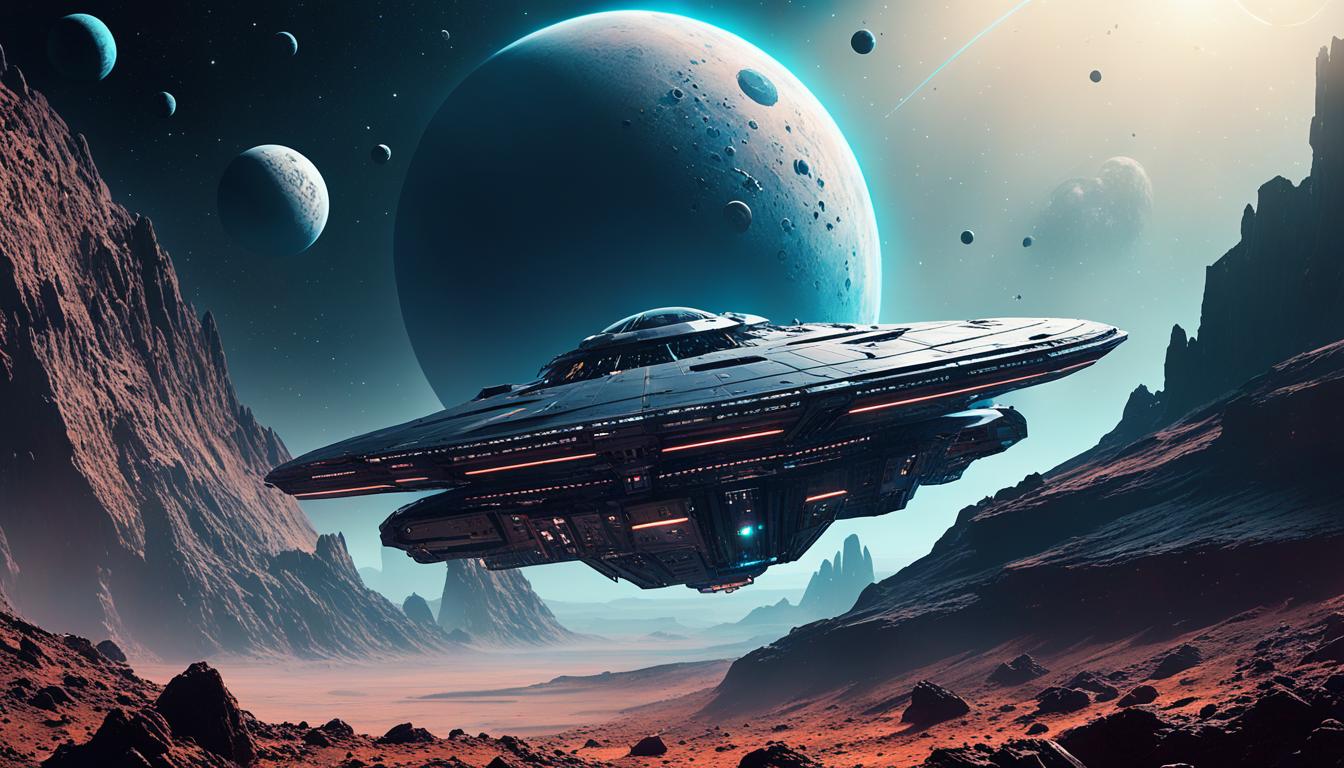
Gear up for an exhilarating new chapter in the realm of space exploration! The Orion spacecraft has recently captured a captivating “selfie” with the Moon, and it’s set to carry astronauts on several exciting upcoming missions. NASA has compiled a comprehensive list of current and scheduled high-profile space missions that span an impressive range of exploration targets, from Mars and the Moon to Jupiter’s moons and distant asteroids.
Among the missions on NASA’s roster are 2001 Mars Odyssey, Aditya-L1, Akatsuki, Ariel, Artemis II, Artemis III, BepiColombo, Chandrayaan-3, Boeing Starliner, Comet Interceptor, DAVINCI, Dragonfly, Emirates Mars Mission, EnVision, EscaPADE, Europa Clipper, Hera, IM-1, JUICE, Juno, Korean Pathfinder Lunar Orbiter, Lucy, Lunar Reconnaissance Orbiter, Mars Express, Mars Sample Return, MAVEN, MMX, Parker Solar Probe, Proba-3, Psyche, SOHO, and SPHEREx. These missions cover a diverse range of exploration targets, including the Red Planet, the Moon, Jupiter and its moons, asteroids, and more.
Key Takeaways
- The Orion spacecraft has taken a “selfie” with the Moon and will carry astronauts on upcoming missions.
- NASA has announced a comprehensive list of current and scheduled high-profile space missions, covering a wide range of exploration targets.
- These missions include missions to Mars, the Moon, Jupiter and its moons, asteroids, and more.
- Private space companies and international collaborations are also contributing to the latest space exploration efforts.
- Technological advancements, such as the Lunar Gateway and next-generation spacesuits, are enabling new frontiers in space exploration.
Ambitious NASA Missions to Mars and the Moon
NASA has announced significant updates to its Artemis campaign, which aims to establish a sustainable human presence on the Moon and pave the way for future Mars exploration. These ambitious NASA missions, including Artemis II and Artemis III, as well as the Mars Sample Return program, are poised to push the boundaries of space exploration and achieve groundbreaking milestones.
Artemis II: Crewed Lunar Flyby
Artemis II, the first crewed Artemis mission around the Moon, is now targeted for September 2025. This mission will send astronauts on a journey to orbit the Moon, marking a crucial step towards the agency’s goal of landing the first woman and person of color on the lunar surface.
Artemis III: First Woman and Person of Color on the Moon
Following the success of Artemis II, NASA is setting its sights on Artemis III, which is planned to land the first astronauts near the lunar South Pole in September 2026. This historic mission will achieve the landmark of placing the first woman and person of color on the Moon, a significant milestone in the history of space exploration.
Mars Sample Return: Bringing Martian Rocks to Earth
Alongside its Artemis missions, NASA is also making progress on the Mars Sample Return program, which involves the Perseverance rover, a lander, and an orbiter. This ambitious endeavor aims to retrieve samples from the Martian surface and deliver them to Earth, allowing scientists to conduct in-depth analysis of the collected Martian rocks and potentially uncover new insights about the Red Planet.
| Mission | Target | Objective | Status |
|---|---|---|---|
| Artemis II | Moon | Crewed lunar flyby | Targeted for September 2025 |
| Artemis III | Moon | First woman and person of color on the Moon | Targeted for September 2026 |
| Mars Sample Return | Mars | Bringing Martian rocks to Earth | Ongoing, involving Perseverance rover, lander, and orbiter |
What are the latest updates on space exploration missions planned for 2025?
As the space industry continues to evolve, both government agencies and private space companies are making significant strides in deep space exploration. NASA is reviewing the schedule for launching the first integrated elements of the Lunar Gateway, a critical component of the Artemis program, to provide additional development time and better align it with the Artemis IV mission in 2028. Additionally, NASA has asked its Artemis human landing system providers, SpaceX and Blue Origin, to start applying the knowledge gained in developing their systems toward future variations that could potentially deliver large cargo on later missions.
Private Space Companies’ Deep Space Probes
While NASA drives forward with its ambitious plans, private space companies are also making their mark on deep space exploration. For example, the Indian Space Research Organisation’s Aditya-L1 mission is set to study the Sun, while the European Space Agency’s Ariel mission will focus on investigating exoplanets. Furthermore, Intuitive Machines’ Odysseus lander recently became the first American-made craft to land on the Moon since 1972, highlighting the growing capabilities of private space companies in deep space missions.
International Collaborations and Missions
Beyond the efforts of individual nations and private companies, there are also various international collaborations shaping the future of space exploration. These collaborative efforts bring together the expertise and resources of multiple space agencies, allowing for the development of cutting-edge missions and the advancement of our understanding of the cosmos. As we look ahead to 2025 and beyond, these international partnerships will continue to play a vital role in unlocking new frontiers in space exploration.

Technological Advancements Enabling New Frontiers
As the space exploration landscape continues to evolve, a new era of technological advancements is paving the way for groundbreaking missions and sustainable lunar exploration. At the heart of this transformation is the Lunar Gateway, a small space station orbiting the Moon that serves as a critical enabler for NASA’s Artemis program.
Lunar Gateway and Sustainable Lunar Exploration
The Lunar Gateway is a key component of the Artemis program, providing a strategic outpost for future lunar missions. This orbiting platform will facilitate sustainable lunar exploration, allowing astronauts to conduct scientific research, test new technologies, and prepare for longer-duration stays on the lunar surface. By establishing a permanent presence around the Moon, the Lunar Gateway will serve as a vital stepping stone for future deep space missions, including potential journeys to Mars.
Next-Generation Spacesuits and Landers
Alongside the Lunar Gateway, the development of next-generation spacesuits and landers is crucial for enabling new frontiers in space exploration. These advanced systems are being designed to support the first woman and person of color to land on the lunar surface as part of the Artemis program. By leveraging cutting-edge technologies, these spacesuits and landers will enhance the capabilities and safety of future astronauts, paving the way for longer-duration stays and more ambitious missions on the Moon and beyond.
The technological advancements powering the Lunar Gateway, next-generation spacesuits, and landers are crucial for unlocking new possibilities in space exploration. These innovations will not only facilitate sustainable lunar exploration but also lay the foundation for future missions to Mars and beyond, ushering in a new era of human presence and discovery beyond our home planet.
Conclusion
The upcoming years promise an exciting new chapter in space exploration, with NASA’s ambitious Artemis missions to the Moon, private space companies’ deep space probes, and international collaborations on cutting-edge projects. These efforts, supported by technological advancements in areas like the Lunar Gateway and next-generation spacesuits and landers, will push the boundaries of what’s possible in space and pave the way for future human exploration of the Moon, Mars, and beyond.
From the Artemis program’s planned crewed lunar flyby and the historic first landing of a woman and person of color on the lunar surface, to the groundbreaking Mars Sample Return mission and the innovative deep space probes from private companies, the future of space exploration is brimming with promise. These advancements, coupled with the development of the Lunar Gateway and cutting-edge technologies, will open new frontiers and inspire generations to come.
As you look ahead to the next few years, be excited for the remarkable feats that lie on the horizon. The space agencies, private companies, and international collaborations driving these missions are poised to make history, unlocking new realms of discovery and pushing the boundaries of human achievement in the final frontier. The possibilities are limitless, and the next chapter of space exploration is about to unfold before your eyes.
FAQ
What are the latest updates on space exploration missions planned for 2025?
NASA has gathered a list of current and scheduled high-profile space missions, including 2001 Mars Odyssey, Aditya-L1, Akatsuki, Ariel, Artemis II, Artemis III, BepiColombo, Chandrayaan-3, Boeing Starliner, Comet Interceptor, DAVINCI, Dragonfly, Emirates Mars Mission, EnVision, EscaPADE, Europa Clipper, Hera, IM-1, JUICE, Juno, Korean Pathfinder Lunar Orbiter, Lucy, Lunar Reconnaissance Orbiter, Mars Express, Mars Sample Return, MAVEN, MMX, Parker Solar Probe, Proba-3, Psyche, SOHO, and SPHEREx. These missions cover a wide range of exploration targets, including Mars, the Moon, Jupiter and its moons, asteroids, and more.
What are the latest updates on NASA’s Artemis missions?
NASA announced updates to its Artemis campaign, including adjusting the schedules for Artemis II and Artemis III missions. Artemis II, the first crewed Artemis mission around the Moon, is now targeted for September 2025. Artemis III, which is planned to land the first astronauts near the lunar South Pole, is targeted for September 2026. The schedule changes are to ensure crew safety and allow time to resolve issues and integrate new systems.
What is the latest update on the Mars Sample Return mission?
The Mars Sample Return mission, involving the Perseverance rover, a lander, and an orbiter, will retrieve samples from Mars and deliver them to Earth.
What are the latest updates on the Lunar Gateway and other technological advancements?
NASA is reviewing the schedule for launching the first integrated elements of the Lunar Gateway, a small space station in orbit around the Moon, to provide additional development time and better align that launch with the Artemis IV mission in 2028. NASA has also asked its Artemis human landing system providers, SpaceX and Blue Origin, to begin applying knowledge gained in developing their systems toward future variations to potentially deliver large cargo on later missions.
What are the latest updates on international collaborations and private space company missions?
In addition to NASA’s missions, there are various international collaborations and private space companies working on deep space probes and exploration, such as the Indian Space Research Organisation’s Aditya-L1 mission to study the Sun, the European Space Agency’s Ariel mission to study exoplanets, and Intuitive Machines’ Odysseus lander that recently became the first American-made craft to land on the Moon since 1972.
